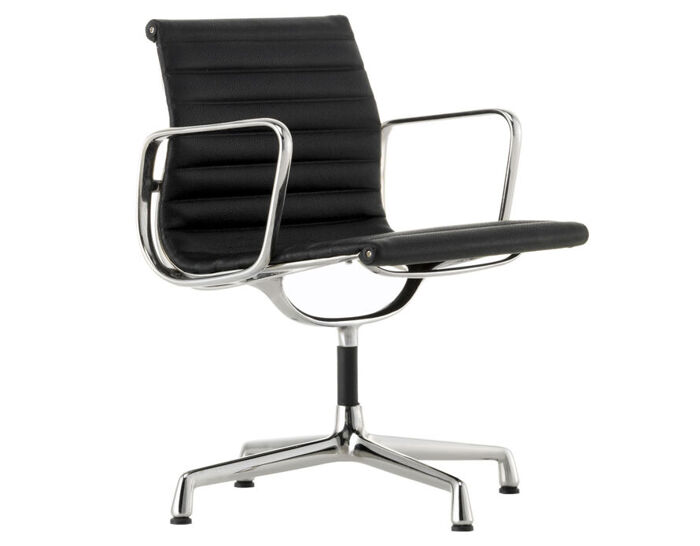miniature eames aluminum group chair
Design Charles & Ray Eames, 1958
1/6 miniature scale model
Made in Poland by Vitra
For over two decades, the Vitra Design Museum has been making miniature replicas of milestones in furniture design. The Miniatures Collection encapsulates the entire history of industrial furniture design - moving from Historicism and Art Nouveau to the New Objectivity of Bauhaus and Radical Design, and from Postmodernism all the way up to the present day. Exactly one sixth of the size of the historical originals, the chairs are all true to scale and precisely recreate the smallest details of construction, material and color. The high standard of authenticity even extends to the natural grain of the wood, the reproduction of screws and the elaborate handicraft techniques involved. This has made the miniatures into popular collector's items as well as ideal illustrative material for universities, design schools and architects.
The furniture making up the indoor-outdoor group goes back to an idea by Alexander Girard and Eero Saarinen, who were looking for furnishings to harmonize with the house they had just completed for Irvin Miller. Girard, one of whose interests as an architect was landscape gardening, complained that though there was a good choice of furniture for interiors, there was nothing to grace attractive patios and no decent garden furniture.
Charles Eames became preoccupied with this problem until one day during a flight he came up with the idea of an aluminum frame construction combined with a soft material seat. He wanted to develop a shape following the natural lines of the body, not however as a hard shell, but as a resilient length of material stretched between two supports which trace the body's natural form. A narrow plastic strip extending the length of the material acts as reinforcement. The material is held in place by insertion into slits on the frame's outer edge.
Experiments with different covering materials later resulted in an upholstered sandwich construction consisting of two layers of Naugahyde with a thin filling of vinyl-foam and vinyl-wadding stitched at intervals of 1.9 inches using a high-frequency welding technique. Originally conceived for outside use, the first aluminum easy chairs to be mass produced, are today used mostly in interiors.
Each Vitra miniature is true to the original in construction and materials, and reduced in size on a scale of 1:6. Each miniature is packaged in a wooden box, accompanied by an informational booklet. Production notes: Each of the delicate objects are made by hand; on average, each miniature requires five hours of careful manual work. Ongoing quality control ensures that every miniature corresponds to its larger original in terms of finishing, details and materials.
5.5" h | 3.9" w | 3.9" d
1/6 miniature scale model
Made in Poland by Vitra
For over two decades, the Vitra Design Museum has been making miniature replicas of milestones in furniture design. The Miniatures Collection encapsulates the entire history of industrial furniture design - moving from Historicism and Art Nouveau to the New Objectivity of Bauhaus and Radical Design, and from Postmodernism all the way up to the present day. Exactly one sixth of the size of the historical originals, the chairs are all true to scale and precisely recreate the smallest details of construction, material and color. The high standard of authenticity even extends to the natural grain of the wood, the reproduction of screws and the elaborate handicraft techniques involved. This has made the miniatures into popular collector's items as well as ideal illustrative material for universities, design schools and architects.
The furniture making up the indoor-outdoor group goes back to an idea by Alexander Girard and Eero Saarinen, who were looking for furnishings to harmonize with the house they had just completed for Irvin Miller. Girard, one of whose interests as an architect was landscape gardening, complained that though there was a good choice of furniture for interiors, there was nothing to grace attractive patios and no decent garden furniture.
Charles Eames became preoccupied with this problem until one day during a flight he came up with the idea of an aluminum frame construction combined with a soft material seat. He wanted to develop a shape following the natural lines of the body, not however as a hard shell, but as a resilient length of material stretched between two supports which trace the body's natural form. A narrow plastic strip extending the length of the material acts as reinforcement. The material is held in place by insertion into slits on the frame's outer edge.
Experiments with different covering materials later resulted in an upholstered sandwich construction consisting of two layers of Naugahyde with a thin filling of vinyl-foam and vinyl-wadding stitched at intervals of 1.9 inches using a high-frequency welding technique. Originally conceived for outside use, the first aluminum easy chairs to be mass produced, are today used mostly in interiors.
Each Vitra miniature is true to the original in construction and materials, and reduced in size on a scale of 1:6. Each miniature is packaged in a wooden box, accompanied by an informational booklet. Production notes: Each of the delicate objects are made by hand; on average, each miniature requires five hours of careful manual work. Ongoing quality control ensures that every miniature corresponds to its larger original in terms of finishing, details and materials.
5.5" h | 3.9" w | 3.9" d
Eames
The primary need of the human being was an essential component of every design for Eames. They believed a design to be successful when it benefited the greatest number of people.
Vitra is a Swiss company dedicated to improving the quality of life through the power of design. A central goal of Vitra is sustainable development. Trendy styling is avoided in favor of classic pieces that can be used for decades.














 write a review now
write a review now
